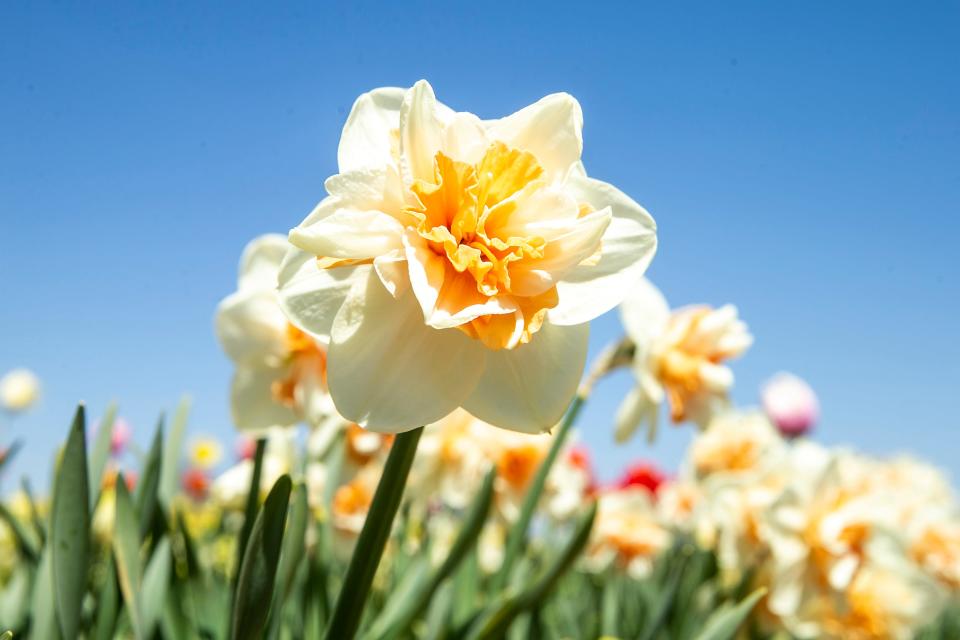Hoping for spring flowers? Start planting bulbs this fall

Autumn is here, and many gardeners like to continue gardening through the season. The crisp, cool weather shouldn’t deter you from adding new plants to your garden or home landscape.
As soon as the leaves begin to fall in autumn, I like to plant spring-flowering bulbs which will provide an early-season splash of color next spring and for years to come. Many spectacular spring flowers grow from bulbs, and although they differ greatly in size, shape and color, they all share one characteristic: They must be planted in the fall.
Gardening tips: September is the best time to divide perennials. Follow these tips
Bulbs are underground stems
The word "bulb" is associated with a family of herbaceous perennial plants that store nourishment for the plant’s life cycle during dormant periods when the weather is either too hot or too cold for them to flower. A true bulb is defined as a modified underground stem usually surrounded by scale-like modified leaves and containing stored food reserves for the shoots enclosed in the bulb. Tulips, daffodils, hyacinths and lilies are examples of true bulbs. Crocus is not a true bulb, but rather a type of bulb called a corm, which is a mass of fleshy tissue with a bud on the top surface. Corms disintegrate each spring as the stored food that makes up the fleshy tissue is used to produce roots and shoots. A new corm then forms on the remains of the old one.
Additional types of bulbs include rhizomes such as irises; tuberous roots such as dahlias; and stem tubers such as potatoes.

Endless variety of spring flowers
Gardeners will find a startling array of spring-flowering bulbs available in a seemingly endless variety of colors and color combinations, size, flower shape and length of the flowering period. Hundreds of different varieties of spring flowering bulbs can be found at local garden centers or by mail directly from growers in the U.S. and in Holland.
For the best selection and quality, purchase bulbs in early fall and store them in a cool dry location until you are ready to plant. Bulbs should be dry and firm to the touch, not soft or spongy. Most dormant bulbs should not show any sprouting or root growth, although lilies are the exception, as these bulbs often have fleshy roots.
Soil temperature indicates planting time
While most spring-flowering bulbs can be planted from September through November, the optimum planting time is when the soil temperature reaches 60 to 65 degrees. Depending on weather variation from season to season, soil temperatures in Greater Columbus typically reach 65 degrees near the first week of October. Planting spring-flowering bulbs in early October will allow them to develop root systems before the ground freezes. This is especially important for daffodils.
Gardening tips: Hoping for a healthy, green lawn next spring? Start preparing your yard now

Proper planting
Spring-flowering bulbs should be planted in locations that receive a minimum of five to six hours of full sun. Locations under deciduous trees or in woodland gardens are adequate, as the bulbs will flower before these trees fully leaf out in the spring.
Bulbs do best in soils with medium fertility and a pH between 6 and 7. Heavier clay soils should be amended with organic matter such as compost for maximum flower size. A complete fertilizer such as 5-10-10 can be applied to the planting bed at a rate of 3 pounds per 100 square feet.
Bulbs should be planted with the pointed end facing up and the fuzzy root end facing down. As a general rule, spring-flowering bulbs should be planted to a depth of approximately three times as deep as the height or size of the bulbs. This means that a 2-inch-tall tulip bulb should be planted 6 inches deep.
Instead of planting single bulbs in a row, consider planting spring-flowering bulbs in clusters for maximum visual effect. Five to seven bulbs can be planted in a large hole dug 15 inches wide and 6 inches deep. To maximize bloom time in your bed, plant a combination of early-, mid-, and late-season bloomers.
If your garden or home landscape is frequented by chipmunks, voles or moles, consider planting bulbs in bulb baskets to prevent these critters from feasting on your bulbs this winter. Bulbs can also be wrapped in ¼-inch mesh hardware cloth to prevent feeding by wildlife.
Very few plants provide the continued satisfaction year after year with as little care and maintenance as spring-flowering bulbs.
Mike Hogan is Extension educator, Agriculture and natural resources and associate professor with Ohio State University Extension. hogan.1@osu.edu
This article originally appeared on The Columbus Dispatch: Garden: Plant bulbs in fall for spring blooming flowers

